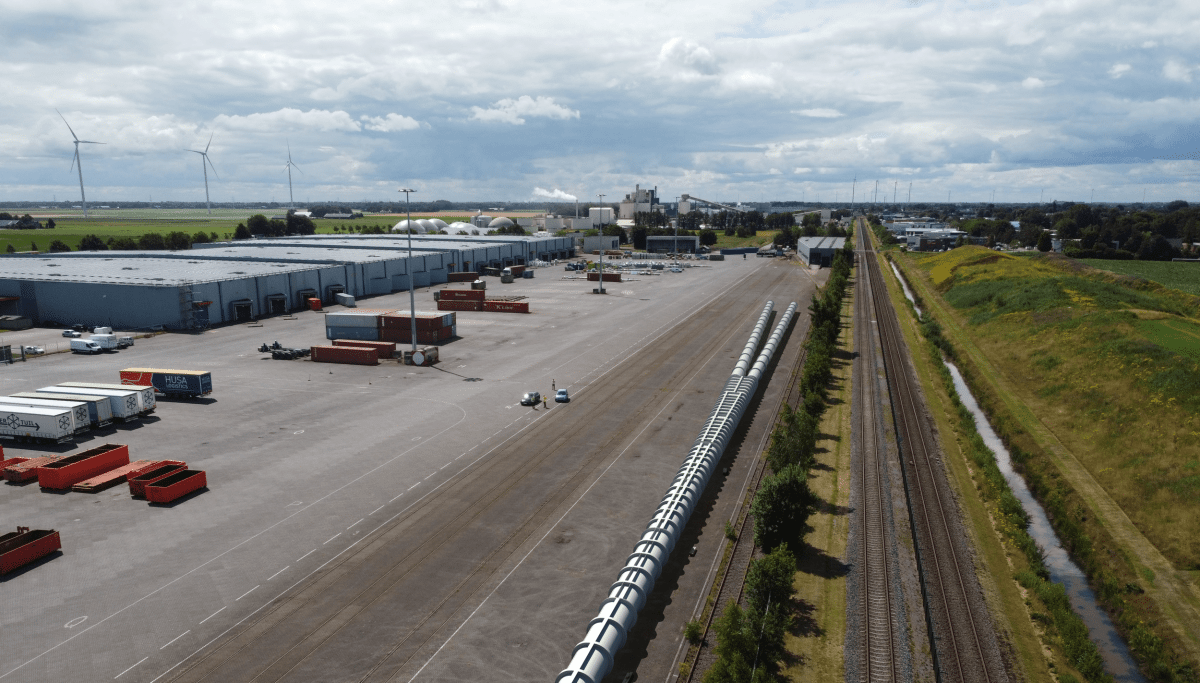The longest Hyperloop test track in Europe was recently opened near Groningen. However, this superlative is put into perspective when you consider the absolute length: 420 meters. This is only enough for speeds of 75 to 100 km/h.
Advertisement
The special thing about the steel tube of the European Hyperloop Center (EHC) is that it contains a switch. Switches are crucial in ensuring that not only a fast point-to-point connection can be built, but also an entire network of paths. And when it comes to maglev trains, switches are a notoriously complicated affair.
The EHC switch works without moving parts. “There are steel rails on both sides of the tube that diverge in the switch. There are guide magnets for both rails on the vehicles. Depending on which magnet you switch on, you follow the left or right track,” explains Mars Geuze. He is Chief Hyperloop Officer of the Dutch company Hardt Hyperloop, which will be the first to test its system there.
Turn in the Hyperloop tube
The two tubes of the test section diverge in a Y-shape at an acute angle. The switch only works in one direction – trains from one arm of the Ypsilon cannot turn into the other arm. A T-junction, where you can change from any direction to any other, like a motorway triangle, would require three such y-switches. How big the switches are depends on the speed at which they are to be driven. At a speed of 200 km/h they would have to be around 120 meters long. At 700 km/h, as Hardt Hyperloop aims for, it would be 560 meters.
A study that Hardt Hyperloop prepared together with Deutsche Bahn Engineering & Consulting shows how such a Hyperloop triangle could be integrated into a route. It’s about a hyperloop route between Bielefeld and Hanover, with two branches near Hanover.
Image 1 of 14 The Hyperloop test track near Groningen measures 420 meters.
(Image: Hardt BV)
Otherwise, the EHC test track essentially consists of a bare steel tube and vacuum pumps. There are no airlocks yet, they are planned for a later upgrade. This means that every time a test vehicle is used, the entire tube must be evacuated for eight hours. And as long as the tube is evacuated, there is no access to the device. According to Hardt Hyperloop, the pumping power required to generate the rough vacuum of one millibar is 22 kilowatts per kilometer. To maintain the pressure, 1 kW/km is probably enough, but this still needs to be tested experimentally.
There are only a few passive steel rails installed inside the tube. Companies that want to test their systems there have to install everything else themselves. With the Hardt Hyperloop concept, that’s not much. It provides capsules for 40 passengers or 12 Euro pallets each, in which the drive and levitation technology is in the vehicle itself, not in the path.
How the cabin in the Hyperloop moves forward
For propulsion, an electromagnet in the vehicle interacts with a series of metal poles on the rail, similar to a reluctance motor. The capsules are made to float by permanent magnets on board that interact with a laminated steel rail. Electromagnets support you and provide guidance. The drive power up to acceleration to 700 km/h should be 3.3 megawatts; according to the manufacturer, 665 kW is sufficient to maintain the speed. The electricity will be supplied by a 640 kWh battery, which can be charged inductively and via recuperation while on the move.
According to Hardt Hyperloop, the system should consume 42 watt hours per passenger kilometer (at 70 percent capacity on a route with 40 percent acceleration and deceleration phases). One to two percent of the total energy requirement is accounted for by the vacuum pumps.
For comparison: According to Deutsche Bahn, an ICE train consumes around 37 Wh per space kilometer at over 200 km/h. At 70 percent capacity utilization, this would correspond to around 53 Wh per passenger kilometer. At first glance, the difference between the systems isn’t that big. However, the calculation for the Hyperloop is based on a speed that is around three times as fast.
The European Hyperloop Center is part of the Hyperloop Development Program (HDP), a public-private partnership with more than 25 partners. The HDP is supported by, among others, the EU Commission and the Dutch government. The EU Commission also wants to include hyperloop routes in its TEN-T program to promote an efficient Europe-wide railway network.
(grh)
To home page
